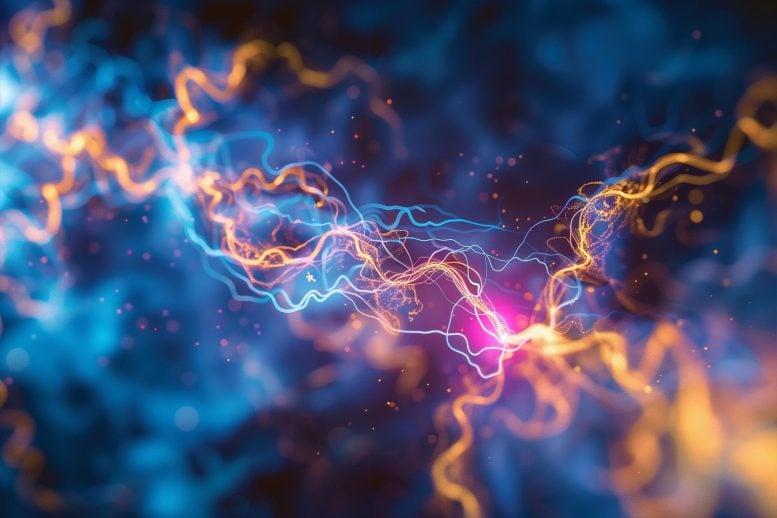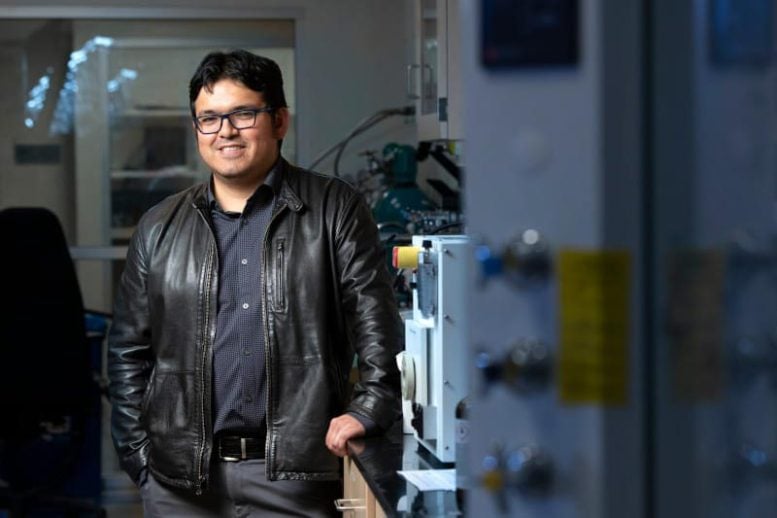
UC Irvine scientists identified a novel quantum state with potential for energy-efficient devices. Its radiation resistance makes it particularly valuable for space missions.
Researchers at the University of California, Irvine have identified a previously unknown state of quantum matter. According to the team, this discovery could pave the way for computers that recharge themselves and withstand the extreme conditions of deep space exploration.
“It’s a new phase of matter, similar to how water can exist as liquid, ice, or vapor,” said Luis A. Jauregui, professor of physics & astronomy at UC Irvine and corresponding author of the new Physical Review Letters. “It’s only been theoretically predicted – no one has ever measured it until now.”
The phase behaves like a fluid formed by electrons and their counterparts, known as “holes,” which spontaneously pair together to create exotic structures called excitons. In a surprising twist, both electrons and holes rotate in the same direction. “It’s its own new thing,” Jauregui said. “If we could hold it in our hands, it would glow a bright, high-frequency light.”
Materials and experimental conditions
The phase was detected in a material engineered at UC Irvine by postdoctoral researcher Jinyu Liu, the study’s first author. Jauregui and his colleagues confirmed its existence using powerful magnetic fields at the Los Alamos National Laboratory (LANL) in New Mexico.

To generate this unusual quantum state, the researchers exposed the material—hafnium pentatelluride—to an intense magnetic field of up to 70 Teslas. (For comparison, a strong refrigerator magnet produces about 0.1 Teslas.) Under these conditions, the material revealed its transformation into the new quantum phase.
Implications for future technology
Jauregui explained that, as his team applied the magnetic field, the “material’s ability to carry electricity suddenly drops, showing that it has transformed into this exotic state,” he said. “This discovery is important because it may allow signals to be carried by spin rather than electrical charge, offering a new path toward energy-efficient technologies like spin-based electronics or quantum devices.”
Unlike conventional materials used in electronics, this new quantum matter isn’t affected by any form of radiation, which makes it an ideal candidate for space travel.
“It could be useful for space missions,” Jauregui said. “If you want computers in space that are going to last, this is one way to make that happen.”
Companies like SpaceX are planning human-piloted space flight to Mars, and to do that effectively, you need computers that can withstand prolonged periods of exposure to radiation.
“We don’t know yet what possibilities will open as a result,” Jauregui said.
Reference: “Possible Spin-Triplet Excitonic Insulator in the Ultraquantum Limit of HfTe5” by Jinyu Liu, Varsha Subramanyan, Robert Welser, Timothy McSorley, Triet Ho, David Graf, Michael T. Pettes, Avadh Saxena, Laurel E. Winter, Shi-Zeng Lin and Luis A. Jauregui, 22 July 2025, Physical Review Letters.
DOI: 10.1103/bj2n-4k2w
Never miss a breakthrough: Join the SciTechDaily newsletter.
9 Comments
“It’s Its Own New Thing” – Scientists Discover New State of Quantum Matter.
VERY GOOD.
Can scientists think deeply?
1. What is quantum matter?
2. What is topological matter?
3. Which is closer to physical reality, quantum matter or topological matter?
Topology provides stability blueprints, but specific physics (spatial features, gravitational collapse, fluid viscosity, quantum measurement) dictates vortex generation, evolution, and decay. In modern physics, topological defects are recognized as non-trivial spacetime structures arising from symmetry-changing phase transitions, ubiquitous from cosmic strings to skyrmions and vortices in condensed matter.
If researchers are interested in this, please visit https://zhuanlan.zhihu.com/p/1945831506376364895, https://zhuanlan.zhihu.com/p/1933484562941457487 and https://zhuanlan.zhihu.com/p/1925124100134790589.
It’s quite pathetic, the way you try to insinuate your way into every discovery in physics with your “vortices” and “topologies.” There is a reason why no journal publishes your “theories” – it’s because they are utter nonsense. Your writings are nonsense word salads devoid of meaning. Stringing together “sciency-sounding” words doesn’t make you a scientist.
If you are interested in contributing to science, try learning about physics first. Trying to impress lay people on a pop-sci sites with your word salads isn’t going to make a difference.
@TheHeck
Thank you for your continuous browsing and comments.
Your behavior and comments are a true reflection of the negative impact of so-called peer-reviewed publications. The so-called peer-reviewed journals—including Physical Review Letters, Nature, Science, and others openly define differences as sameness, sameness as differences, existence as nonexistence, and nonexistence as existence—all while deceiving and fooling the public with so-called “impact factors (IF)”. Some so-called ‘peer-reviewed’ publications are ideologically outdated and entrenched in vested interests. They remain complacent within their insular circles, wholly divorced from notions of sordidness, ugliness, and shame.
Philosopher Thomas Kuhn in The Structure of Scientific Revolutions noted science often progresses through “paradigm shifts” with incommensurability between old and new paradigms. Human cognition of nature’s essence is undergoing a profound shift from “universal gravitation” to “universal spin.” This transition not only addresses old theory limitations but philosophically reshapes our cosmic view.
If researchers are interested in this, please visit https://zhuanlan.zhihu.com/p/1943715764965188178.
Seriously, go kick rocks. TheHeck is correct and your inability to defend your “work” is a testament to why your “research” doesn’t get published. The fact that you tried to redefine words in your initial post is a problem, and one that no actual scientist will ever care about.
I will also suggest to go learn about physics, and I suggest starting at a middle school level for you.
Part of the peer review process is being able to defend, which is something you have thus far been unable to do. Leave us alone until you learn actual sciences rather than your made up nonsense that has no basis in reality.
VERY GOOD!
Your behavior and comments are a true reflection of the negative impact of so-called peer-reviewed publications. An entire generation has been severely misled, poisoned and fooled by so-called peer-reviewed publications. In today’s physics, the so-called peer-reviewed journals—including Physical Review Letters, Nature, Science, and others—stubbornly insist on and promote the following:
1. Even though θ and τ particles exhibit differences in experiments, physics can claim they are the same particle. This is science.
2. Even though topological vortices and antivortices have identical structures and opposite rotational directions, physics can define their structures and directions as entirely different. This is science.
3. Even though two sets of cobalt-60 rotate in opposite directions and experiments reveal asymmetry, physics can still define them as mirror images of each other. This is science.
4. Even though vortex structures are ubiquitous—from cosmic accretion disks to particle spins—physics must insist that vortex structures do not exist and require verification. Only the particles that like God, Demonic, or Angelic are the most fundamental structures of the universe. This is science.
5. Even though everything occupies space and maintains its existence in time, physics must still debate and insist on whether space exists and whether time is a figment of the human mind. This is science.
6. Even though space, with its non-stick, incompressible, and isotropic characteristics, provides a solid foundation for the development of physics, physics must still insist that the ideal fluid properties of space do not exist. This is science.
and so on.
The so-called peer-reviewed journals—including Physical Review Letters, Nature, Science, and others openly define differences as sameness, sameness as differences, existence as nonexistence, and nonexistence as existence—all while deceiving and fooling the public with so-called “impact factors (IF),” never knowing what shame is.
At this point they’re just making sh!t up, aren’t they?
Or, at the very least, they COULD be making sh!t up and none of us would know, because all this “advanced science” is so far removed from our day-to-day experience that we don’t really have the means to objectively appraise their methods and findings.
Only if some practical utility ever comes out of all this lab bruhaha will I be willing to say “hats off, guys”. But something tells me it never will.
The journal article is available right there at the bottom for you to review. Not sure why you would say that it’s made up if you’ve actually read the published work.
In today’s physics, the so-called peer-reviewed journals—including Physical Review Letters, Nature, Science, and others—stubbornly insist on and promote the following:
1. Even though θ and τ particles exhibit differences in experiments, physics can claim they are the same particle. This is science.
2. Even though topological vortices and antivortices have identical structures and opposite rotational directions, physics can define their structures and directions as entirely different. This is science.
3. Even though two sets of cobalt-60 rotate in opposite directions and experiments reveal asymmetry, physics can still define them as mirror images of each other. This is science.
4. Even though vortex structures are ubiquitous—from cosmic accretion disks to particle spins—physics must insist that vortex structures do not exist and require verification. Only the particles that like God, Demonic, or Angelic are the most fundamental structures of the universe. This is science.
5. Even though everything occupies space and maintains its existence in time, physics must still debate and insist on whether space exists and whether time is a figment of the human mind. This is science.
6. Even though space, with its non-stick, incompressible, and isotropic characteristics, provides a solid foundation for the development of physics, physics must still insist that the ideal fluid properties of space do not exist. This is science.
and so on.